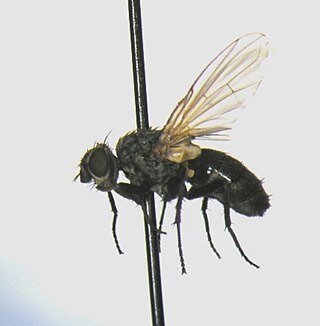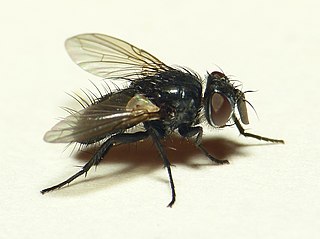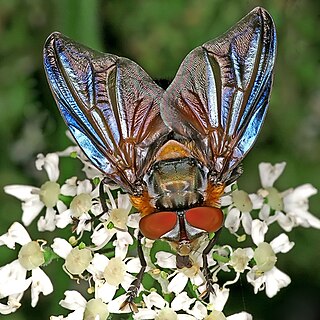
The Tachinidae are a large and variable family of true flies within the insect order Diptera, with more than 8,200 known species and many more to be discovered. Over 1,300 species have been described in North America alone. Insects in this family commonly are called tachinid flies or simply tachinids. As far as is known, they all are protelean parasitoids, or occasionally parasites, of arthropods, usually other insects. The family is known from many habitats in all zoogeographical regions and is especially diverse in South America.

Calyptratae is a subsection of Schizophora in the insect order Diptera, commonly referred to as the calyptrate muscoids. It consists of those flies which possess a calypter that covers the halteres, among which are some of the most familiar of all flies, such as the house fly.

Oestroidea is a superfamily of Calyptratae including the blow flies, bot flies, flesh flies, and their relatives. It occurs worldwide and has about 15,000 described species.

Phytomyptera is a genus of flies in the family Tachinidae.
Plesina is a genus of flies in the family Tachinidae.
Wattia is a genus of flies in the family Tachinidae. 3 species have been described, W. ferruginea, W. petiolata and W. sessilis. The species, now extinct was discovered by John Russell Malloch in 1938. It is classified in the subfamily Tachininae and in the family Tachinidae. The genus was originally found in New Zealand.

Exoristinae is a subfamily of flies in the family Tachinidae. Most species are parasitoids of caterpillars.

Blondeliini is a tribe of parasitic flies in the family Tachinidae. Larvae are parasitoids of other insects, mostly beetles and caterpillars. Although nearly cosmopolitan, its greatest diversity is in the New World and especially in South America.

Ligeria angusticornis is a European species of fly in the family Tachinidae.

Phasiinae is a subfamily of flies in the family Tachinidae. Except for the small tribe Strongygastrini members of this subfamily attack only Heteroptera.

Compsilura concinnata is a parasitoid native to Europe that was introduced to North America in 1906 to control invasive populations of the exotic gypsy moth , which primarily infests forests. The fly is an endoparasitoid of insect larvae that lives within its host for most of its life. The parasitoid eventually kills the host and occasionally eats it. It attacks over 200 host species, mainly insects from the orders Coleoptera, Lepidoptera, and Hymenoptera.

Tachininae is a subfamily of flies in the family Tachinidae.
Sturmiopsis inferens is a species of fly in the family Tachinidae. It is native to Asia and is a parasitoid of various moth species whose larvae feed inside the stems of sugarcane, rice and other large grasses, including the Gurdaspur borer and the sugarcane shoot borer.
Cyrtophloeba coquilletti is a species of fly in the family Tachinidae. It is a parasitoid of Megalopyge crispata and Epiglaea apiata moths.
Jurinia pompalis is a species of bristle fly in the family Tachinidae.
Opsotheresia bigelowi is a species of bristle fly in the family Tachinidae.
Lypha setifacies is a species of bristle fly in the family Tachinidae.
Microchaetina mexicana is a species of fly in the family Tachinidae.
Leschenaultia halisidotae is a species of bristle fly in the family Tachinidae.
Spathidexia dunningii is a species of fly in the family Tachinidae.







